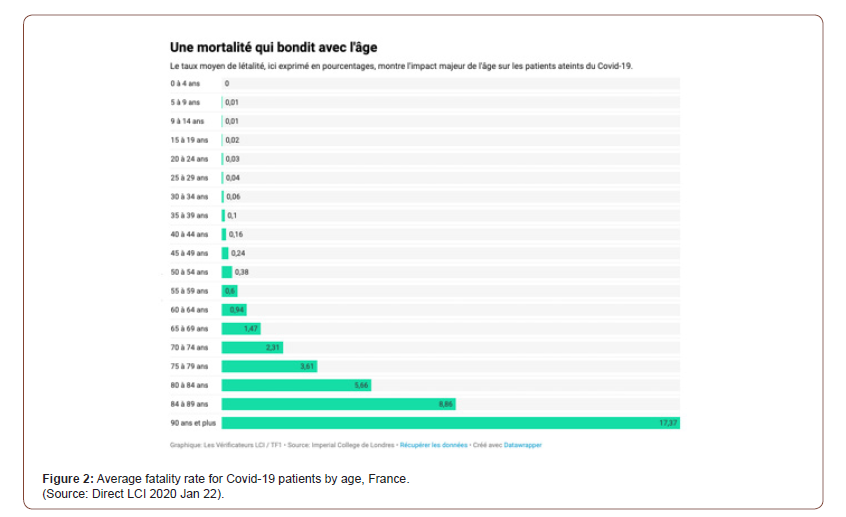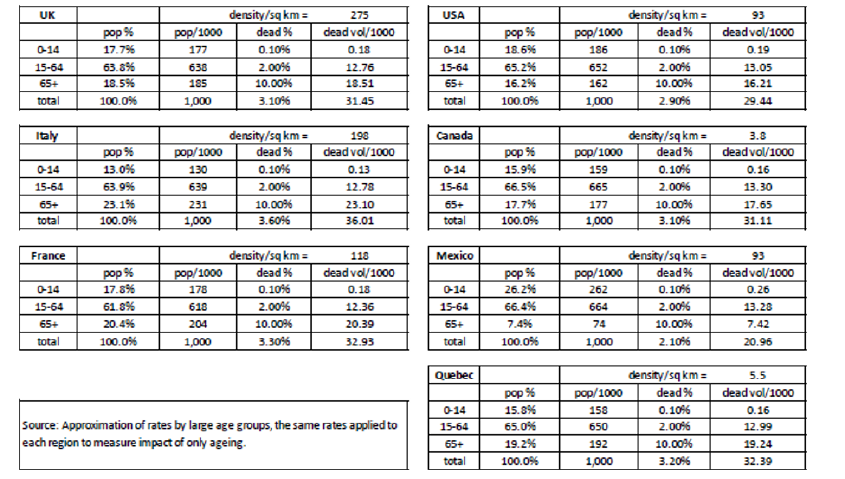 Opinion
Opinion
Some Thoughts Around Aging, Density, And Measuring the Covid-19 Pandemic
Yves Daniel BUSSIÈRE*
Faculty of Economics, Benemérita Universidad Autótonoma de Puebla, Pue, Mexico
Yves Daniel BUSSIÈRE, Faculty of Economics, Benemérita Universidad Autótonoma de Puebla, Pue, Mexico.
Received Date: January 21, 2021; Published Date: February 23, 2021
Abstract
In January 2021, it is still too early to measure the full impact importance of the Covid-19 pandemic and, especially, make comparisons between countries. Faulty or deficient information is frequent, especially in populist countries, and socioeconomic contexts are often quite different. In the absence of detailed data, we propose some preliminary thoughts on the importance of considering the impact of aging and density in evaluating the success or failure of different policy-reactions to the pandemic of various countries in Europe and America.
Keywords: Aging; Covid-19; Density; Indicators; Pandemic.
Introduction
Starting from a few known cases, end of 2019 and early 2020, the covid-19 pandemic is actually a world pandemic which, early 2021, has reached 95 million cases and over 2 million deaths with a fatality rate of 2.14% Worldmeter [1], jan17. We may be surprised of such an increase, but we must remember that exponential growth may lead to surprises. For example, if we start with one case and each following day, we have a contagion rate of 12% adding up each day, we will reach 240 cases after 30 days, 8,368 after 60 days, 250,952 after 90 days and so on with 6,749,643,836 after 6 months (180 days). A staggering number. If the contagion rate was lowered to 10%, we would reach 310,510,291 after 6 months. A simple example to show that controlling the contagion rate is extremely important and a small difference may have an enormous impact.
For example, when Donald Trump was informed of the presence of covid-19 in the USA in mid-February 2020 and the importance of immediate actions, there were around 17 known cases in the country Bolton [2]. But denial followed with no immediate action. Now the number reaches 24,4 million total cases and still spreading Worldmeter [1]. These staggering figures show the importance of acting rapidly in a pandemic and also the importance of having reliable indicators.
In this article we offer some thoughts on how to interpret data on the pandemic of different countries taking into account various socioeconomic contexts such as deficient information, aging, density.
Deficient or False Information
The right to information is generally not fully observed in countries where you have a populist government. United States with Donald Trump is an example. For months, the severity of the pandemic was denied as well as the importance of wearing protective masks despite such advise by the World Health Organization (WHO). The same tendency was observed in Brasil with Bolsonaro president, with 8,5 million cases Worldmeter [1]. We can also associate populist states with fake news or incomplete information which leads to false information. A notable example is Mexico, with Lopez Obrador president, also a populist, where the severity of the pandemic was initialiy denied. In his “mañaneras” of April 4th, 2020 (daily morning TV broadcasts) he said on Covid-19 that “you have to hug, nothing happens ´like a ring on your finger´” (Figure 1). March 25th of 2020, Miguel Barbosa, the governor of the State of Puebla was saying that the poor are immune to Covid-19 Forbes Staff [3]. In June 2020, the Bishop of Cuernavaca in Mexico claimed that Covid-19 is a divine punishment for homosexuality and abortion López-Dóriga, [4]. Too often, when faced with a catastrophe, the first reaction is denial. But, at least, in the State of Puebla, schools and universities were closed mid-March with teaching online and are still closed early 2021.


In Mexico, the official policy was and still is to abstain from doing systematic detection tests (declared too costly) but are still published every day the number of new cases, which obviously underestimates reality. Mexico has made only 31,620 tests per million population compared to 855,563 in USA, a factor of 27 Worldmeter [1].
A more reliable measure is most probably the number of deaths. Per million habitants in the USA vs. Mexico we obtain similar results 1,222 vs. 1,082. Even though this measure may not be perfect for institutional or political reasons, we will use it to compare various countries of Europe and America.
Aging
Europe shows considerable aging compared to USA, Canada or Mexico. In 2019 the proportion of the population aged 65 and over was the following: Italy 23.10%, France 20.29%, UK 18.51%, compared to USA 16.2%, Canada 17.65%, Quebec, a sub region of Canada 19.24%., Mexico 7.42%. However, the “oldest country” is Japan with 28.4%.
Europe shows considerable aging compared to USA, Canada or Mexico. In 2019 the proportion of the population aged 65 and over was the following: Italy 23.10%, France 20.29%, UK 18.51%, compared to USA 16.2%, Canada 17.65%, Quebec, a sub region of Canada 19.24%., Mexico 7.42%. However, the “oldest country” is Japan with 28.4%.
We tried to show in a straightforward method the impact of age on mortality rates due to the coronavirus using a simple age structure (0-14, 15-64, 65+) to a population of 1,000 and applying the same rates of coronavirus per age groups for 7 regions: UK, Italy, France, USA, Canada, Mexico, and the canadian sub-region of Quebec (Table 1). The results show that age has an important impact. For a population of 1,000, from highest to lowest, the number of deaths we would obtain would be: Italy 36, France 33, UK 31, Quebec 32, Canada 31, USA 29, Mexico 21. The impact of age is obviously significant: Between Italy and Mexico the difference is 71.4%.
Table 1:Simulation of impact of age in 7 regions for a population of 1,000 - data of 2019.

Density
One should expect that density is also an important factor. World population is mostly urban (56%) in 2019 and very high in the 6 countries of our analysis (UK, 84%, Italy, 71%, France, 81%, USA, 82%, Canada, 81%, Mexico 80% World Bank [6].
However, with roughly the same level of urbanization, European cities have much higher densities than in USA or Canada, Mexico being an exception with rather high densities, a legacy of the Spanish European mode of urbanization. In dense cities, use of public transport dominates and the risks of contagion are much higher. It would be interesting but out of range of this article for falting data to compare case studies of large vs. medium or small cities. We restrained ourselves with national densities. The respective densities per km2 in 2019 were: UK 275, Italy 198, France 118, USA 93, Quebec 5.5, Canada 3.8, Mexico 93. With more detailed analysis in further research, we may find that, among other factors, the difficulties to fight the pandemic in UK and Italy was due to an aged population but also very high densities.
Comparing Canada vs USA in terms of density and use of public transit makes sense. Both countries benefit from a similar mode of urbanization where the use of the private car dominates. With the indicator - deaths for one million habitants - we obtain 1,222 in USA and 473 in Canada, a huge difference, not explained by only slight differences in aging. Comparing both we may conclude that Canada´s fight against the pandemic with early restriction measures was much more successful than in the USA. Acting early is crucial. Comparing situations in Europe with USA is difficult because of enormous differences in aging and density as well as cultural factors. However, if we compare France with Quebec, both having similar cultural traditions and implemented similar early strong restriction measures for the first wave of coronavirus as well as the recent second wave implying strong fines. France has 1,073 deaths per million habitants and Quebec 969 World meter [1] - a difference of only 11% which would be partially due to aging and density. The difference of Canada and Quebec (473 vs. 969) can be explained by slightly stronger aging in Quebec and by local factors of the earlier spread of the pandemic in Quebec where in the early phase of the pandemic, at a time when we were not yet aware its seriousness, school holidays implying contagion due to international trips occurred a week or so earlier than the neighboring province of Ontario.
Other factors
Certainly, other factors more difficult to measure played a role in succeeding or no in fighting the pandemic. Mentalities and level of resistance to restrictive measures. Differences in systems of law and order as the presence (in Canada) or absence (in Mexico) of heavy fines in case of non-observance of restrictions.
Conclusion - Discussion
Establishing relevant social indicators in different instances can be complex, particularly in the rapid occurrence of events such a pandemic when data is still missing. In the case of the present pandemic, it appears important to consider aging and density.
In the future, will the pandemic leave important social lessons? The impact on urban mobility was tremendous (strong decrease in daily mobility and use of public transport, stimulating bike use, rise in telecomuting in the range of 20% in some areas compared to less than 3% without pandemic [7].
In the short term, the introduction of effective vaccines from the end of 2019 may contain the progression of the pandemic but it will take some time before millions of vaccines are administered (60% -70% of the population) to ensure a form of collective immunity. In the longer term, optimists propose that the pandemic could be a severe warning to necessary actions front of global warming. On the other hand, let us recall the strong opposition in USA and other countries to accepting the pandemic, to wearing a protective mask or restricting mobility policies to reduce risks of contagion, in front of a short-term formidable enemy of possible imminent death. With such a reaction, we can fear we might react even less and too late in front of global warming which will lead to more dramatic impacts, but which is still a diffuse long-term threat suffering much misinformation and denials, but irreversible.
Conflict of interest:
None.
Acknowledgments:
None.
References
- World meter (2021).
- Bolton, John (2020) The Room Where It Happened: A White House Memoir Simon & Schuystrer. El Universal.
- Forbes Staff (2020) Institut de la statistique du Quebec.
- López Dóriga (2020).
- LCI (Direct LCI) (2020).
- World Bank (2020) donnébanquemondiale.org/indicator.
- Bussière Y, Paul Lewis (2002) Impact of telework and flexitime on reducing future travel demand: the case of Montreal and Quebec (Canada) In: LJ Sucharov, CA Brebbia, F Benitez (Eds.), Urban Transport VII: Urban Transport and the Environment in the 21st Century, Southampton, Boston, WIT Press, USA, pp. 279-298.
-
Yves Daniel BUSSIÈRE. Some Thoughts Around Aging, Density, And Measuring the Covid-19 Pandemic. Glob J Aging Geriatr Res. 1(3): 2021. GJAGR.MS.ID.000512.
-
Elderly population; Mild cognitive impairment; Neurodegenerative disorders.
-

This work is licensed under a Creative Commons Attribution-NonCommercial 4.0 International License.






